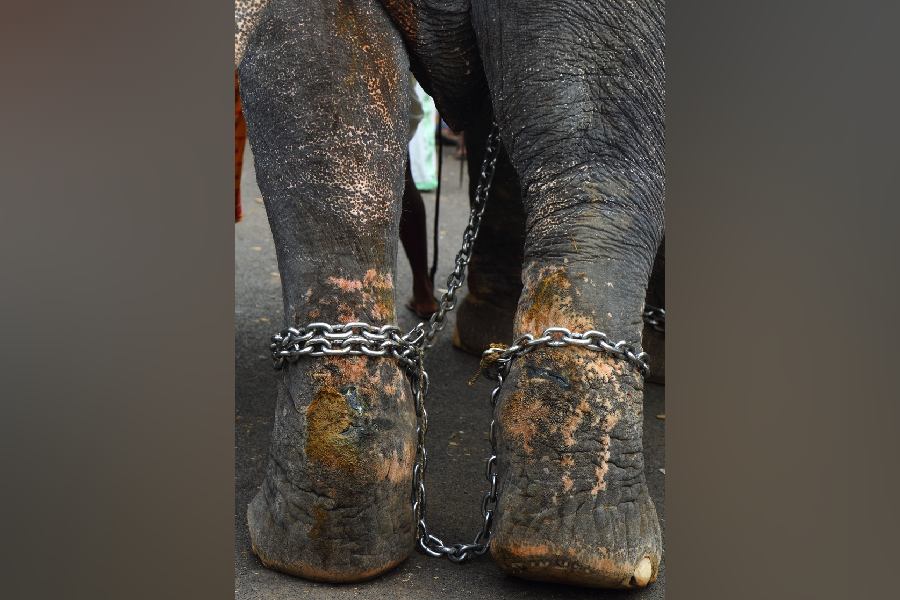 |
A tiny tobacco container packed with explosives and ball bearings went off at Chandni Chowk on Friday afternoon while a second bomb device was defused, triggering a wave of panic that soon set off a Twitter blast.
The explosion around 12.20pm just a few feet from Chandni Chowk Metro station was more a thud than a boom, but the sight of smoke and people scurrying for cover was enough for many to press the panic button.
“I was playing games on my father’s mobile phone when I heard a noise and saw a puff of smoke,” recounted 10-year-old Vikrant Kumar.
The kid was in his father’s paan stall on Madan Street and had no idea that police would soon find a second bomb device below the kiosk.
The blast had occurred around 15 feet away and steel balls — the police identified them as cycle ball bearings — lay strewn along with the charred tobacco container.
Traffic cops from Central Avenue, Madan Street and Prafulla Sarkar Street cordoned off the site while a bomb disposal squad arrived to scan the area. The second container, with both ends wrapped in brown tape, was found between two bricks underneath the kiosk.
An examination revealed the contents of the second container to be a mixture of potassium, sulphur and charcoal dust, all common components of firecrackers. “There were also bicycle ball bearings, which could have been meant to work as splinters,” said an officer of the bomb squad.
 |
The police had first thought the cause of the blast to be a short-circuit in a Calcutta Telephones distribution point. “The explosive device wasn’t designed to cause casualties. Troublemakers sometimes use such devices to just scare people,” said an officer of the detective department.
It was the choice of location rather than the blast that had the police brass worried. “This is one of the city’s busier areas and hence the risk of damage is high,” a senior officer said.
Low-intensity strikes are often used by outfits to measure how the police and people react. By late afternoon, the city seemed to have taken the explosion in its stride, but a bigger blast rocked cyberspace. Tweets flew thick and fast, spreading the news about Calcutta being rocked by a blast less than 48 hours after the arrest of explosion mastermind Yasin Bhatkal.
A young woman whose office is close to Chandni Chowk said she stepped out midway through her lunch to check “if a blast had indeed rocked Calcutta”. E-Mall, the retail electronics hub, downed shutters and didn’t reopen until the police lifted the cordon around 1.30pm.
Two sniffer dogs had been brought to scan the area. Men from the bomb squad came with their gear but one of them allegedly wore only a part of the protective suit while handling the second container.
A member of the Siliguri bomb squad had died 24 hours earlier while trying to defuse an explosive device in Alipurduar without protective gear.
tobacco can with explosives & ball bearings goes off
How was the device made?
The explosive was stashed in a chewing tobacco container. A conventional container has openings at both ends and two chambers — one for choona and the other for tobacco. In this box, the partition in the middle had been removed so that it had one chamber filled with explosives. Both ends of the metal container were sealed with brown tape.
What did it contain?
A mix of potassium, sulphur and charcoal dust, which is typical of low-intensity explosives like those used in crackers. Bicycle ball bearings and paper strips dotted with gunpowder that children use in toy guns were also packed in. The steel balls were either meant to have the effect of splinters or to hammer the gunpowder strips to trigger an explosion.
How powerful was it?
According to Calcutta police, the range of the device was “not more than 20 feet”. No one within that “range” was injured on Friday. Explosives experts said this may be because of the lack of enough explosives and use of low-grade materials or the absence of enough pressure to generate heat for a larger explosion.
The explosion even failed to rip the container. It merely uncorked the lids at both ends.
How was the explosion triggered?
Preliminary examinations by the police suggest that it had either hit against something or had been stepped upon.
Who uses such a device?
The police said petty criminals use them often to scare away rivals creating sound and smoke. The same explosives, when packed under more pressure can trigger an explosion with a bigger bang, like the ones in crackers. For the blast to cause more damage, high-intensity explosives had to be used.
How did it reach the busy intersection?
The cops are clueless about whether they had been left behind accidentally or intentionally.
Does the choice of location signify anything?
Any explosion, however small, is bound to create ripples when it takes place in a crowded intersection near a mall and a Metro station. If the explosives were indeed placed there intentionally, they were more to create panic than cause damage. A Lalbazar source said such low-intensity explosions are often triggered to measure the response of the police and people.
When was the last time Calcutta saw such a blast?
A powerful explosion had ripped open a part of a pavement on Shakespeare Sarani in 2008, disfiguring a tree trunk and dismantling road railings. Though no one was injured, what caused the blast is still a mystery to the police.
Monalisa Chaudhuri and Pronab Mondal










